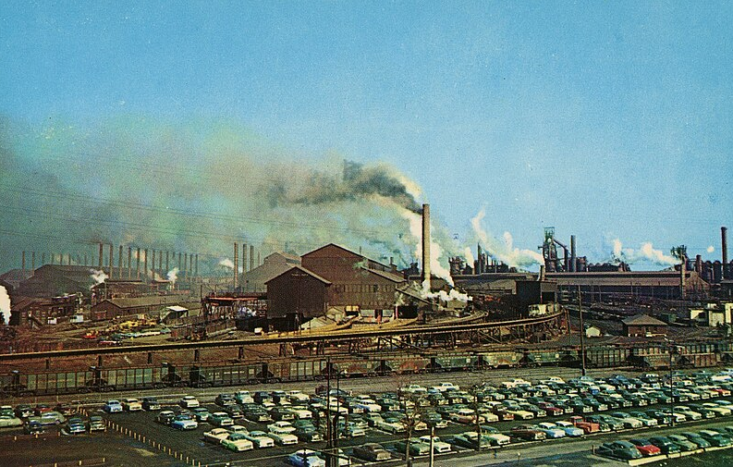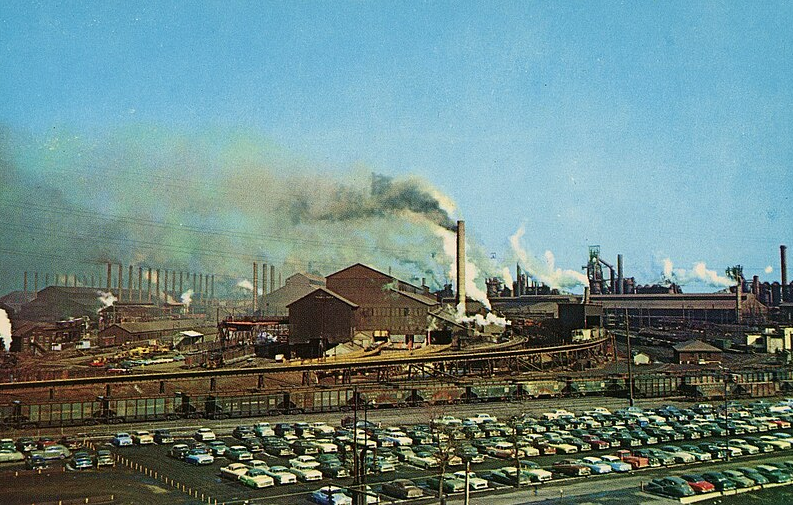The Biden administration claims to have many priorities:
1. Addressing global warming
2. Strengthening our alliances in the China region
3. Mercantilist policies aimed at domestic job creation
In fact, not everything can be a priority. Based on their actions, it appears the administration has one overriding priority—domestic jobs. The Inflation Reduction Act has been much less effective in addressing global warming than had been hoped, partly due to protectionist provisions that have sharply raised the cost of clean energy.
Now we see evidence that building an alliance of democratic East Asian nations is less important than protecting jobs in Pennsylvania. Here’s the FT:
Nippon Steel announced the controversial acquisition in December, leading Biden to pick a side between a powerful union and its voters, and a critical American ally. The president has invested heavily in shoring up alliances, particularly with Japan.
The White House asked US ambassador to Japan Rahm Emanuel to make the problem go away, putting him in a tough position after he had publicly welcomed the deal as “historic”. Emanuel did not respond to a request for comment.
One person familiar with the deliberations said it was “embarrassing” for an administration that talks about the importance of allies and particularly the US-Japan alliance to “send a signal of distrust regarding Japanese ownership of US companies” as Kishida prepares to visit.
“The president knows all this, but sadly it looks like election year politics will win out,” the person said.
I certainly understand the politics of the situation. But I also believe that these examples demonstrate the internal contradictions of nationalism. The Biden administration seems to wish to embrace both nationalism and globalism (i.e. international cooperation.) That’s not possible—you cannot prioritize everything.
PS. I suspect that a future Trump administration would drop the globalism, and go all in for nationalism.
PPS. Below is a picture of the US Steel plant in Gary, taken in 1959. We drove through Gary in 1959, on the way to visit my grandparents. Its population was 178,000 (similar to Austin or Nashville). Today, it’s 69,000. I still recall the smell from the air pollution.



READER COMMENTS
TMC
Mar 15 2024 at 5:31pm
He’s not prioritizing domestic jobs, just union jobs. They act as a money laundering scheme and return a percentage – let’s call it a ‘vig’ – to the Democratic party. Looks at the teacher’s unions for further evidence. This is what an actual RICO prosecution would look like.
Thomas L Hutcheson
Mar 15 2024 at 6:44pm
The “jobs” priority is especially problematic, Only the Fed can create and destroy jobs. The “jobs” supposedly created by deficit-finance IRA have to be netted out against the jobs not created by the private investment deterred by the higher interest rates that deficits cause when the Fed is carrying out FAIT.
Philo
Mar 16 2024 at 10:47pm
Yes, a politician in power cares little about jobs; the public perception of jobs is what matters.
Thomas L Hutcheson
Mar 19 2024 at 12:48pm
Yes. The macroeconomic dominance of monetary policy needs to be more widely understood. But for the present, I’ll be happy if we can just get politicians and pundits to understand.
BC
Mar 16 2024 at 5:05am
I haven’t followed news about Nippon Steel’s acquisition of US Steel closely, but I don’t think this even qualifies as traditional mercantilism to protect domestic jobs. We’re talking about an acquisition, not trade barriers to steel imports. I think this just reflects a fourth priority, which is Biden’s actual top priority: making unions more powerful.
According to this Bloomberg article [https://www.bloomberg.com/news/articles/2024-03-13/no-labor-agreement-no-deal-steel-union-draws-line-for-nippon], the union is using its political influence over the Biden Administration as leverage in its negotiations with Nippon Steel: “The United Steelworkers and Nippon Steel Corp. are staking out bargaining positions for a deal that would potentially smooth the purchase of United States Steel Corp. — a key test of whether the union will ultimately back the deal and clear the way for the Biden administration to approve it….Biden is expected to soon release a statement of concern about the deal, the latest show of support from the administration for the steel union as it seeks to win better terms.” So, Biden is basically misappropriating powers intended for national security (CFIUS) and instead delegating those powers to the union to use as a bargaining chip: “The union doesn’t have any official right to simply block an offer US Steel has accepted, but it holds unique political leverage.”
I’ve heard that unions use environmental impact procedures similarly. When a construction project comes up for environmental review, the union will threaten to oppose the project on environmental impact grounds — even though the project will actually provide lots of union jobs — just to extract concessions.
I can see why one might call this anti-globalist. But, I wouldn’t necessarily call it nationalist, given that China is an adversary and Japan is arguably our strongest ally in checking China. It’s more like a conflict of interest between national security on the one hand and private gains by union members on the other. I’m sure someone can explain how this is different from the inherent conflict in the Trump family benefiting privately from receiving trademarks in China while wielding foreign policy powers, I mean other than the fact that unions aren’t even supposed to have these foreign policy powers “officially”…
Warren Platts
Mar 17 2024 at 12:48pm
The acquisition will create American jobs because Nippon Steel wants to expand production here in the U.S. (Probably just because of Trump’s steel tariffs, actually.)
Jon Murphy
Mar 17 2024 at 1:20pm
Probably not. Given the tariffs are 7 years old at this point and have failed to increase quantity demanded, it’s unlikely they’re a cause here. One would have to wonder why US Steel couldn’t increase production by themselves; why would a merger need to happen?
No, there is likely a different story here.
Jon Murphy
Mar 17 2024 at 3:14pm
Also, I thought the whole point of tariffs was to reduce the trade deficit and stop sales of American assets to foreigners (especially items necessary for national defence). Odd to see you here celebrating an increase of the deficit and the sale of American national security assets to a foreign power we were at war with not too long ago. Indeed, you state that this state of affairs is due to the tariffs.
I guess they failed in that policy goal too.
Michael S.
Mar 20 2024 at 3:45am
just so I understand: are you calling 1945 “not too long ago”?
Jon Murphy
Mar 20 2024 at 5:33am
Correct. 1945 was a mere 80 years ago. Given the grand scale of years nationalists (and Mr Platts in particular) play on, 80 years might as well be yesterday.
Warren Platts
Mar 20 2024 at 4:13pm
Jon, you’ve been reading too many Tom Clancy novels lately. There is no Japanese conspiracy to take revenge on the United States because of World War II. Japan is one of the best, most solid allies we got. The deal will enhance both U.S. and Japanese national security against the common enemy that is China.
As for the steel tariffs, they worked as they were designed to:
https://www.usitc.gov/press_room/news_release/2023/er0315_63679.htm
Michael Sandifer
Mar 16 2024 at 8:56am
While Biden is somewhat of a believer in industrial policy, as you indicate, the politics hold sway. If he’s right on the politics, we can’t blame him for not wanting to chance losing one of the few swing states that matter in the Presidential election. If the prospect of losing to Trump wasn’t so consequential, and/or the Democrats ran a more popular candidate, they could have more flexibility in this regard.
steve
Mar 16 2024 at 10:05am
Getting re-elected is always the first priority.
Steve
Scott Sumner
Mar 16 2024 at 6:40pm
Everyone, Good point about the union jobs being the primary goal.
TGGP
Mar 16 2024 at 9:17pm
Ezra Klein & then Matthew Yglesias called this sort of thing “Everything-Bagel Liberalism“, leading to confusion because there is a popular style of bagel with that name that in fact has only a select few ingredients on it.
Jim Glass
Mar 16 2024 at 9:28pm
Priority #1: Get re-elected. Else: End Stop.
“the … administration seems to wish to embrace both nationalism and globalism”
Thus, shackled by isolationist protectionism, while greatly desiring to address growing risks abroad, the President campaigns for re-election stridently promising…
This after he had decided the US was going to be in WWII, begun re-arming ASAP, and ordered the Navy to harass German U-boats hoping to create a war-justifying incident — with shooting between them actually starting not long after this speech, in early 1941, well before the US “officially” entered WWII.
The Biden administration seems to wish to embrace both nationalism and globalism (i.e. international cooperation.) That’s not possible—you cannot prioritize everything.
This is not right. We all prioritize lots of things in our lives. Prioritizing success at my job does not mean I can’t successfully prioritize my health and my relationship with my kids. “Everything” <> multiple important things,
And as to this particular clash of priorities in politics, to the extent this is true it is hardly new — it is 101 politics and always has been. Often much worse than today: FDR 1940, LBJ “guns and butter”, Woodrow Wilson out-in-WWI…
And, as FDR 1940 demonstrated, given a politician sufficiently skilled in politics, lying and deceit to be able to fool enough of the people enough of the time, one can indeed embrace contradictory priorities and win. I’d consider it one of the base requirements of the profession.
Comments are closed.